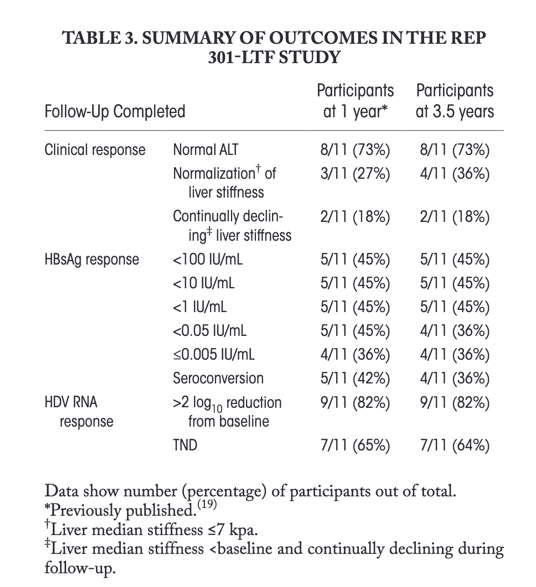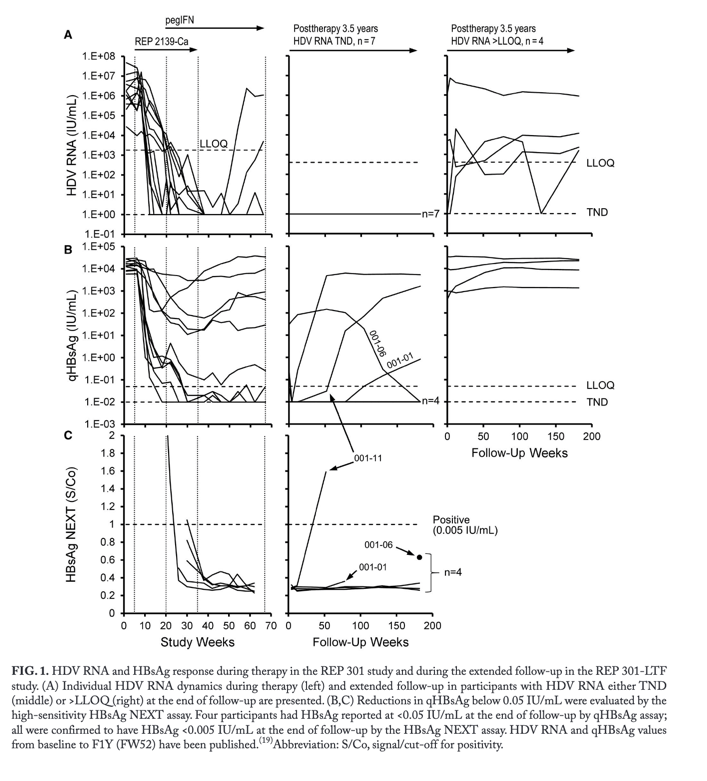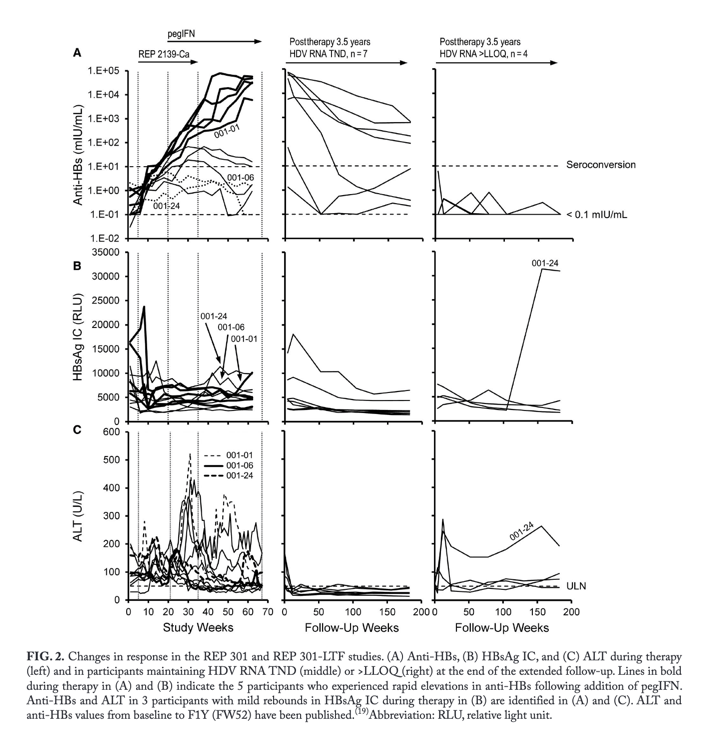| |
Persistent Control of Hepatitis B Virus and Hepatitis
Delta Virus Infection Following REP 2139-Ca and Pegylated
Interferon Therapy in Chronic Hepatitis B Virus/Hepatitis Delta Virus Coinfection
|
| |
| |
Download the PDF here
13 November 2020
Abstract
The nucleic acid polymer REP 2139 inhibits assembly/secretion of hepatitis B virus (HBV) subviral particles. Previously, REP 2139-Ca and pegylated interferon (pegIFN) in HBV/hepatitis delta virus (HDV) coinfection achieved high rates of HDV RNA and hepatitis B surface antigen (HBsAg) loss/seroconversion in the REP 301 study (NCT02233075). The REP 301-LTF study (NCT02876419) examined safety and efficacy during 3.5 years of follow-up. In the current study, participants completing therapy in the REP 301 study were followed for 3.5 years. Primary outcomes were safety and tolerability, and secondary outcomes were HDV functional cure (HDV RNA target not detected [TND], normal alanine aminotransferase [ALT]), HBV virologic control (HBV DNA ≤2,000 IU/mL, normal ALT), HBV functional cure (HBV DNA TND; HBsAg <0.05 IU/mL, normal ALT), and HBsAg seroconversion. Supplemental analysis included high-sensitivity HBsAg (Abbott ARCHITECT HBsAg NEXT), HBV pregenomic RNA (pgRNA), HBsAg/hepatitis B surface antibody (anti-HBs) immune complexes (HBsAg ICs), and hepatitis B core-related antigen (HBcrAg). Asymptomatic grade 1-2 ALT elevations occurred in 2 participants accompanying viral rebound; no other safety or tolerability issues were observed. During therapy and follow-up, HBsAg reductions to <0.05 IU/mL were also <0.005 IU/mL. HBsAg ICs declined in 7 of 11 participants during REP 2139-Ca monotherapy and in 10 of 11 participants during follow-up. HDV functional cure persisted in 7 of 11 participants; HBV virologic control persisted in 3 and functional cure (with HBsAg seroconversion) persisted in 4 of these participants. Functional cure of HBV was accompanied by HBV pgRNA TND and HBcrAg < lower limit of quantitation. Conclusion: REP 2139-Ca + pegIFN is not associated with long-term safety or tolerability issues. The establishment of HDV functional cure and HBV virologic control/functional cure and HBsAg seroconversion are durable over 3.5 years and may reflect removal of integrated HBV DNA from the liver. Further investigation is warranted in larger studies.


Chronic hepatitis delta virus (HDV) infection is one of the most aggressive forms of viral hepatitis,(1, 2) affecting up to 40 million individuals worldwide.(3, 4) HDV is an obligate satellite infection of chronic hepatitis B virus (HBV) infection, requiring the HBV surface antigen (HBsAg) protein for its envelopment(2) through the same assembly and secretion pathway as HBV subviral particles (SVPs).(5)Clearance of HBsAg from the circulation during therapy of HBV/HDV coinfection is considered to be essential for the functional cure of both HDV(6, 7) (HDV RNA target not detected [TND] with normal alanine aminotransferase [ALT] in the absence of therapy) and HBV(8, 9) (HBV DNA TND; HBsAg <0.05 IU/mL with normal ALT in the absence of therapy). Attempting to control HDV infection with nucleos(t)ide analog HBV reverse-transcriptase inhibitors (NUCs) is largely ineffective because HDV replication can be supported by HBsAg derived only from integrated HBV DNA,(10-12) which is not affected by NUCs. Pegylated interferon (pegIFN) can achieve clearance of HDV RNA but with little effect on HBsAg, even when combined with NUCs,(12, 13) and rebound of HDV RNA occurs in a significant proportion of subjects after removal of therapy.(13, 14)
Nucleic acid polymers (NAPs) are oligonucleotides with broad spectrum antiviral activity that increases with length and is saturated at 40 nucleotides.(15, 16) This activity is dependent on phosphorothioate modification of internucleotide linkages but is independent of sequence composition or sugar modifications.(15, 16) This broad spectrum antiviral activity is driven by interaction with structurally similar exposed hydrophobic surfaces of amphipathic alpha helices, which have been identified in many confirmed targets for NAPs in viral and nonviral infectious agents.(16) REP 2139 is a NAP optimized for tolerability and formulation by the adoption of a poly adenosine–cytidine sequence and complete 2′ O-methylation of the ribose sugar, which does not have any impact on antiviral activity(17, 18) but removes off-target effects and maximizes drug solubility.(16) REP 2139 selectively blocks the assembly of SVPs derived from covalently closed circular DNA (cccDNA) or integrated HBV DNA.(19-21) This effect is driven by the interaction with an as yet unidentified host protein(19, 22) with an exposed hydrophobic surface(20) similar to target domains for NAPs confirmed in other viral and nonviral infectious systems.(16) The inhibition of SVP assembly by REP 2139 simultaneously blocks the release of HBsAg and lowers intracellular HBsAg(20) without affecting the production of viral proteins or the secretion of hepatitis B e antigen (HBeAg) or Dane particles.(21) REP 2139 has been shown to directly interact with the large and small forms of the hepatitis delta antigen (HDAg),(22) which is consistent with the nonspecific interaction of other oligonucleotides with HDAg.(23, 24)
Preclinical studies with a variety of NAPs, including REP 2055 and REP 2139,(15, 16) have verified the sequence and sugar modification-independent effects on HBV infection, including the clearance of HBV DNA and HBsAg from both the circulation and the liver.(18, 25, 26) Further, multilog reduction of cccDNA in the liver persists after removal of therapy.(25, 26) Clinical studies with the NAPs REP 2055 and REP 2139(17, 19, 27) in monotherapy have confirmed these results in vivo, including HBsAg loss and seroconversion, HBeAg seroconversion (in subjects who are HBeAg positive), HBV DNA, HBV RNA, and HDV RNA loss (in patients coinfected with HDV). When combined with immunotherapies, such as thymosin α1 and pegIFN, REP 2139-based combination therapy was accompanied by rapid HBsAg clearance and seroconversion; high rates of therapeutic transaminase flares; HBV DNA, HBV RNA, hepatitis B core-related antigen (HBcrAg), and HDV RNA clearance during therapy(19); and high rates of functional cure of HBV and HDV.(19, 28)
The REP 301-LTF study (NCT02876419) investigated the long-term safety and efficacy following therapy with REP 2139-Ca and pegIFN in the REP 301 study (NCT02233075).(19) In the current study, long-term evaluation extended the total follow-up after removal of all therapy to 3.5 years and demonstrated the long-term stability of functional cure of HBV and HDV with no safety issues related to this therapy. Several experimental virologic parameters were additionally analyzed during therapy in the REP 301 and REP 301-LTF studies. The extent of HBsAg reduction during the REP 301 and REP 301-LTF studies was examined using a high-sensitivity HBsAg test capable of detecting HBsAg concentrations in serum as low as 0.005 IU/mL.(29) The role of hepatitis B surface antibody (anti-HBs) in clearing HBsAg was examined using a research assay for HBsAg/anti-HBs immune complexes (ICs). Additionally, changes in serum HBV pregenomic RNA (pgRNA) and HBcrAg were evaluated.
Study Design
The REP 301 study was an open-label, nonrandomized study of the safety and efficacy of REP 2139-Ca in monotherapy, transitioning to combination therapy with pegIFN followed by monotherapy with pegIFN in 12 participants with treatment-naive chronic HBV/HDV coinfection.(19) REP 301-LTF was a long-term follow-up study in which 11 of 12 participants completing therapy were evaluated every 6 months for 3 years (for a total of 3.5 years of follow-up). The first visit in REP 301-LTF (6 months from the final 24-week follow-up in the REP 301 study) has been published.(19) The REP 301 protocol has been published,(19) and the REP 301-LTF protocol can be found at http://replicor.com/wp-content/uploads/2020/09/REP301.pdf.
Primary outcomes were the safety and tolerability of REP 2139-Ca + pegIFN therapy over the 3 years of follow-up. Secondary outcomes were maintenance of virologic control of HBV (HBV DNA ≤2,000 IU/mL with normal ALT), functional cure of HBV (HBV DNA TND; HBsAg <0.05 IU/mL), HBsAg seroconversion, and functional cure of HDV (HDV RNA TND with normal ALT).
The REP 301-LTF study was conducted at the Toma Ciorbă Infectious Diseases Hospital, and complete data were available in November 2019. The study was compliant with current Good Clinical Practice and the Declaration of Helsinki and approved by the National Ethics Committee and National Medicines Agency of the Republic of Moldova. Protocol deviations


|
|
| |
| |
|
|
|